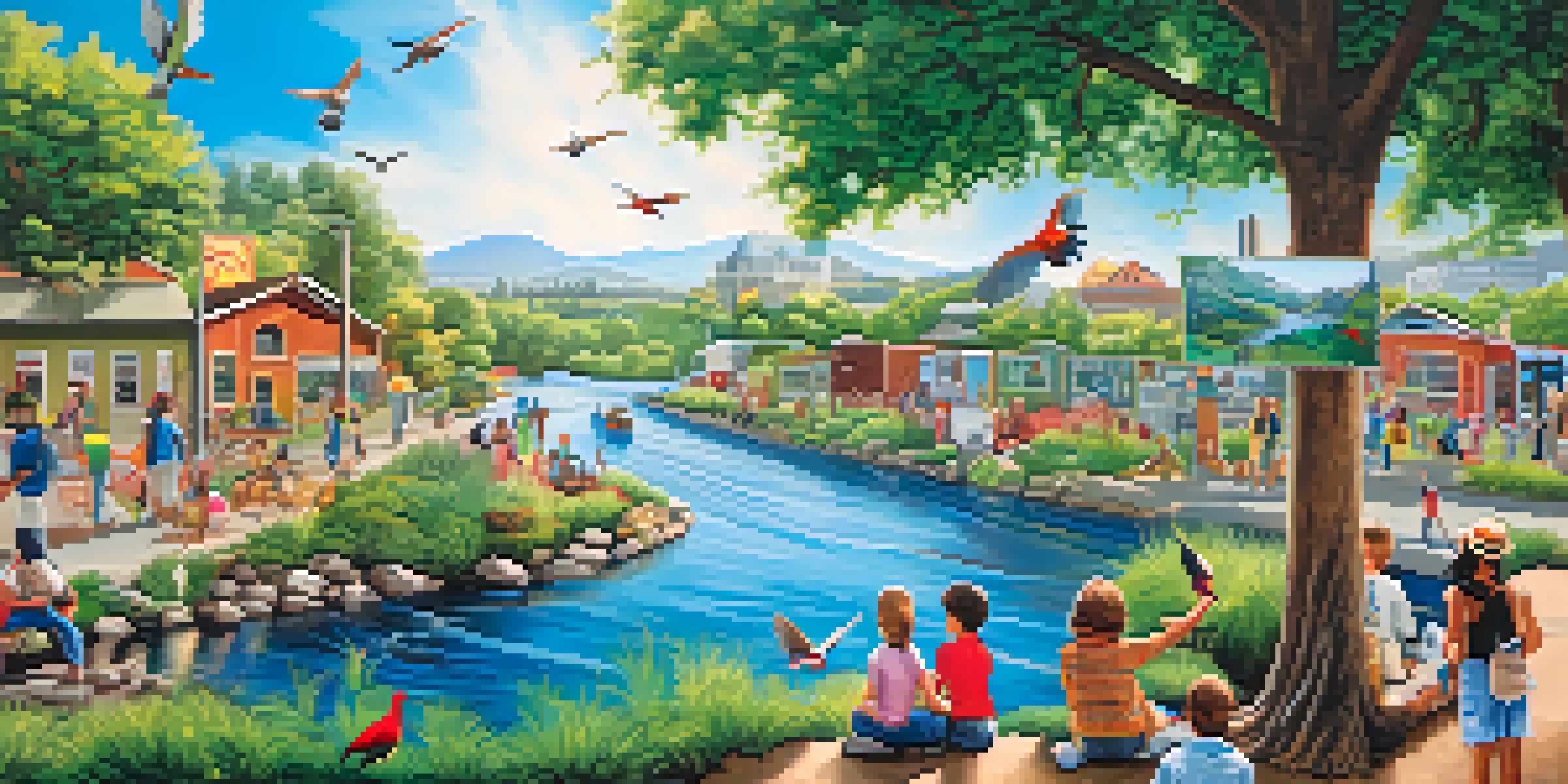Artistic Expressions in the Fight Against Climate Change

The Power of Art in Environmental Awareness
Art transcends traditional communication methods, tapping into emotions to convey powerful messages. In the context of climate change, artists are using their mediums to capture the urgency and importance of environmental issues. Visual art, music, literature, and performance can provoke thought, inspire action, and foster a deeper connection to nature.
Art is not a mirror held up to reality, but a hammer with which to shape it.
Consider how a striking painting or an impactful song can linger in our minds long after experiencing it. These artistic expressions not only reflect the beauty of our planet but also highlight the dire consequences of inaction. For many, this emotional resonance is a catalyst for change, prompting individuals to reconsider their relationship with the environment.
Through art, we are reminded that climate change is not just a scientific issue; it’s a human one. By blending creativity with activism, artists are challenging us to engage, reflect, and ultimately act in the fight against climate change.
Art as a Catalyst for Community Engagement
Art can unite communities around a common cause, fostering collaboration and dialogue. Public art installations, community murals, and interactive performances serve as platforms for discussion about climate change, encouraging collective action. When people come together to create or experience art, they often feel a stronger sense of connection to one another and the environment.

For instance, consider a community mural that depicts local wildlife and natural landscapes. This tangible representation not only beautifies the neighborhood but also serves as a reminder of what’s at stake. Such projects often spark conversations and inspire community members to take tangible steps toward sustainability.
Art Inspires Environmental Action
Artists use various mediums to evoke emotions that inspire individuals to engage with and take action on climate change.
Engaging with art can empower individuals to become advocates for change, as they feel more invested in their community and its future. Through shared artistic experiences, people can develop a collective vision for a sustainable world, reinforcing the idea that every voice matters in the fight against climate change.
The Role of Digital Art in Climate Activism
In our increasingly digital world, online platforms have become vital tools for climate activism. Digital art, whether through social media campaigns, virtual galleries, or interactive websites, allows artists to reach a global audience with their messages. This accessibility democratizes art and activism, enabling anyone with an internet connection to engage with important environmental issues.
We do not inherit the earth from our ancestors; we borrow it from our children.
Artists are leveraging technology to create immersive experiences that can transport audiences to the frontlines of climate change. For example, virtual reality experiences can simulate the effects of rising sea levels or deforestation, making the impact of climate change visceral and immediate. These innovative approaches can leave a lasting impression, compelling viewers to take action.
Moreover, digital art can easily be shared and spread, amplifying its reach and influence. As more people engage with these creative expressions online, the conversation around climate change becomes more widespread, reinforcing the idea that collective action is not only necessary but also possible.
Storytelling Through Literature and Poetry
Literature and poetry have long served as powerful vehicles for social change. Writers use storytelling to explore complex themes, including humanity's relationship with the environment. Through poignant narratives and lyrical poetry, authors can evoke empathy and inspire readers to reflect on their impact on the planet.
Consider the profound effect of a novel that depicts a world ravaged by climate change. Such stories not only entertain but also educate and inform, making readers acutely aware of the potential consequences of inaction. They encourage us to envision alternative futures and motivate us to be part of the solution.
Community Engagement Through Art
Public art initiatives foster collaboration and dialogue, uniting communities in the fight against environmental issues.
In this way, literature becomes a bridge between individual experiences and broader environmental issues. By sharing personal stories and connecting them to the global narrative of climate change, writers can inspire a sense of urgency and agency among readers.
Music: A Universal Language for Climate Action
Music has a unique ability to transcend barriers, making it an effective tool for climate advocacy. Songs that address environmental themes can resonate deeply, rallying listeners around a common cause. From folk anthems to powerful protest songs, music can inspire movements and encourage people to take action.
For example, many artists are using their platform to raise awareness about climate change through benefit concerts and eco-conscious lyrics. These initiatives not only entertain but also educate audiences, creating a sense of community around the shared goal of environmental preservation. The emotional power of music can inspire listeners to join the fight, whether through activism, lifestyle changes, or simply spreading the word.
Moreover, music festivals often promote sustainability practices, making them a model for eco-friendly events. By demonstrating that entertainment and environmental responsibility can coexist, musicians are leading by example and showing that everyone can play a part in the fight against climate change.
The Impact of Film and Documentary on Awareness
Film and documentary have the power to shape public perception and drive social change. Through compelling visuals and storytelling, filmmakers can highlight the realities of climate change, making complex issues accessible to a broad audience. Documentaries like 'Chasing Ice' and 'Before the Flood' have played a significant role in raising awareness and inspiring action.
These visual narratives allow viewers to witness the effects of climate change firsthand, often stirring emotional responses that motivate action. By presenting scientific data in a relatable format, filmmakers can bridge the gap between experts and the general public, making climate issues more tangible.
Digital Art Amplifies Climate Messages
Online platforms enable artists to reach global audiences, making climate activism more accessible and impactful.
Furthermore, film festivals focused on environmental themes provide a platform for diverse voices and perspectives. By showcasing a variety of stories, these festivals encourage dialogue and collaboration among artists, scientists, and activists, fostering a collaborative approach to tackling climate change.
Fashion as a Medium for Environmental Advocacy
The fashion industry is increasingly recognizing its role in the climate crisis, with many designers using their platforms to promote sustainability. Fashion can be a powerful medium for environmental advocacy, as it blends creativity with consumer influence. Eco-friendly designs and sustainable practices are becoming more mainstream, encouraging consumers to think critically about their purchases.
For instance, brands that utilize recycled materials or promote slow fashion are not only creating beautiful products but also fostering awareness about the environmental impact of fast fashion. By showcasing these values, designers can influence consumer behavior and inspire others in the industry to adopt more sustainable practices.

Moreover, fashion shows and campaigns can serve as platforms for raising awareness about climate change. By integrating environmental messages into their work, designers are contributing to a larger cultural conversation about sustainability, challenging the industry to rethink its impact and encouraging consumers to make more responsible choices.